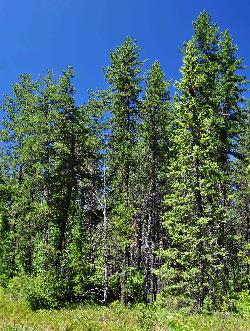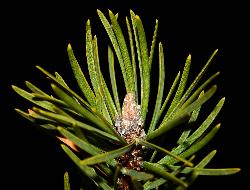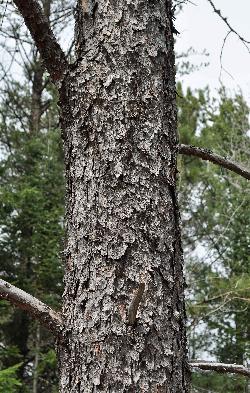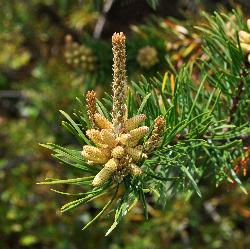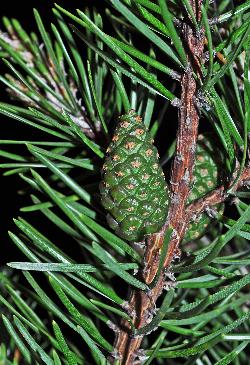Fr: pin gris, pin de Banks
IA: ussishk, unuiashiku
Pinaceae - Pine Family
Note: Numbers provided in square brackets in the text refer to the image presented above; image numbers are displayed to the lower left of each image.
General: A moderately long-lived (to 150 years), small to medium-sized evergreen tree [1–5], 20–27 m tall, with a d.b.h. of 30–60 cm (Farrar 1995, Kral 1993). Jack pine is shade-intolerant, well adapted to dry sandy sites, and is a pioneer species on exposed sites and burns. It is also deep-rooted and windfirm, with a taproot that develops (up to 2.7 m deep) before the lateral roots, which occur mainly within the upper 15 cm of soil (Rudolph & Laidly 1990). Jack pine is rare in Labrador and absent from Newfoundland, except in plantations. Due to its limited native range within the province, jack pine is not harvested commercially, but it does occur in research plantations [6] and as a landscape tree.
Key Features:
- Jack pine has 2 needles per fascicles, needles are short, 2–5 cm long, stiff, mainly straight, and divergent [7–8].
- Fascicle sheaths are persistent for the lifetime of the needles, but become shorter with age [7–8].
- Cones are serotinous, light brown, asymmetric to curved, and 3–5.5 cm long [9].
Jack pine is classified as a hard pine (subgenus Pinus). In addition to the needle traits listed above, jack pine shares the following traits of hard pines: needles have 2 vascular bundles, stomata occur on all needle surfaces, cones are sessile, cone scales have a somewhat central mucronate umbo on each apophysis, cone scales are sealed shut by resin after fertilization, and the wood is high in density, with an abrupt transition from earlywood to latewood.
Stems/twigs: Twigs are reddish-brown to dark brown and glabrous; older branches are grey. Buds are ovoid, 1–1.5 cm long, scaly, very resinous [10], and pointed (acute) to blunt (obtuse). Trunks are greyish-brown, straight or crooked (depending on site and stand condition); in closed stands, trunks often bear numerous dead branches. Bark is reddish-brown to grey, becoming flakey and furrowed with age [11–12].
Needles: Evergreen, simple, sessile, and in fascicles of 2 needles [7–8]. Jack pine needles are short, stiff, straight to slightly twisted, 2–5 cm long by 1–2 mm wide, yellowish green to green, divergent, pointed (acute) at the apex, and persist on the stem for 2–3 years [13]. The needles are semi-circular in cross-section and bear numerous parallel rows of stomates on both flat and curved needle surfaces; margins are finely serrulate. Each fascicle of needles is bound at the base by a tubular sheath, 3–6 mm long, composed of overlapping rows of somewhat persistent brownish translucent bracts [14]; sheaths on older fascicles are shorter than first year sheaths.
Reproductive structures/cones: Unisexual; trees monoecious, with separate male and female cones on different branches of the same tree. Male cones are cylindrical-ellipsoid, 10–15 mm long, reddish brown to yellow, with several whorls of cones at the base of new growth [15–16]; male cones turn brown after pollen is released, then cones are shed [17]; pollination is by wind (anemophily). Immature female cones (conelets) are ovoid, dark red to brown, erect, with 1–3 conelets terminal on short lateral shoots at the base of new growth [18]; each conelet scale bears a recurved mucronate umbos [19]. Year-old cones are small, ovoid, and retain the recurved mucronate umbos on each scale [20]. In their second year, cones are green [21], shiny, and mature to tan or light brown [22]. Mature seed cones are narrowly conical, 3–5.5 cm long, nearly straight to asymmetric or curved [23–25], semi-serotinous, sessile, and take 2 years to mature. Cone scale ends (apophyses) are slightly depressed near the base, often with a small apiculate tip (remains of the mucronate umbo). Cone scales become woody and may spread apart at maturity [26–27], releasing their seeds, or cones may remain closed [28–29] for several years until fire prompts seeds release. The dark brown obovoid seeds are 4–5 mm long, with a pale wing, 1–1.2 cm long; dispersal is mainly by wind (anemochory).
Ecology and Habitat: Within Newfoundland and Labrador, jack pine is only known from one small native population in western Labrador, near the Québec border, which is also its most easterly location in Canada. Jack pine is a species that prefers very dry to dry nutrient poor soils in areas of high fire frequency. It forms pure stands in continental areas where the fire frequency is less than 150 years and elsewhere it occurs as an associate in black spruce-dominated forests or early succession aspen stands. It is unlikely that it could persist in balsam fir forests within the maritime climate, where fire frequency exceeds 250–500 years.
Edaphic Grid: See image [30]: the Edaphic Grid for Pinus banksiana.
Forest Types: Jack Pine was not recorded in the forest ecosystem classification descriptions in Newfoundland (Damman 1963, 1964, and 1967; Meades 1986) and Labrador (Wilton 1965; Foster 1984). A review of ecosite classifications in Québec and Ontario would suggest it occupies very dry to dry nutrient-poor soils.
Succession: Jack Pine is considered to be an early successional species maintained on the landscape by frequent wild fires. Its ability to survive high fire frequency is attributed to the production of serotinous cones on trees as young as 10 years old. Asselin et al. (2003) note that there is a strong correlation between the distribution of jack pine and the frequency of fires greater than 200 ha. They also note that seed viability is poor at the northern limit of jack pine.
Distribution: Within the province, jack pine is known from only one location in southwestern Labrador. In 1990, the Red Fir Lake-Kapitagas Channel Jack Pine Ecological Reserve was established to protect this rare population in southwestern Labrador. In North America, its natural range extends from the Mackenzie River in the Northwest Territories, east to Nova Scotia and south to New England and the Lake States (Rudolph and Laidly 1990).
Similar Species: Red pine (Pinus resinosa Aiton) has the same number of needles (2 per fascicle) as jack pine, but red pine is easily distinguished by its long needles, 10–16 cm long, and symmetric cones, 4–7 cm long. Scots pine (Pinus sylvestris L.), a European plantation species, is most similar to jack pine; they both have 2 stiff needles per fascicle, but Scots pine has somewhat longer needles, 4–8 cm long, and the scales of mature cone have raised, 4-sided ends (apophyses).


